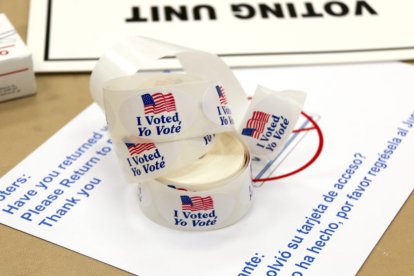Midterms: Hispanic vote no longer guaranteed for the Democratic Party
Although the Hispanic vote continues to lean left, the GOP is increasingly attracting the Hispanic-American community, including a milestone in Miami-Dade.

(OSCE)
The Democratic Party is no longer guaranteed the Hispanic vote. The midterm results made it clear that Hispanic voters are leaning more and more conservative. While it is true that the midterm elections did not produce the red wave that many predicted - in which Hispanics would have played a key role - it is also true that the Hispanic vote can no longer be taken for granted by the Democratic Party.
An estimated 34.5 million Hispanics were eligible to vote in the midterm elections, making the Hispanic-American community the fastest growing group in the electorate over the past four years. The number of Hispanic voters has increased by 4.7 million since 2018, accounting for 62% of the total voter growth in the country during this time.
According to exit polls collected by CNN, this significant number of voters is swinging - albeit slowly - to the Republican Party. Four years ago, Democratic support among Hispanic men was 63% and is now below 55%. Further, Republicans appear to be cutting into the Democrats' lead among Hispanic women, although Democrats still continue to draw support from about two-thirds of them, according to the NBC exit poll.
These data seem to indicate the beginning of the end of what was once a guaranteed vote for the Democratic Party, at least as far as the Hispanic-American community is concerned. Republicans have also cut down the gap in the youth vote. Other traditional Democratic strongholds, such as the black vote, continue to swing clearly to the Democratic side.
Miami-Dade County and the end of the guaranteed vote for Democrats
In midterm elections, turnout rates among Hispanics were typically lower than those of other groups. However, the Hispanic presence was especially notable in some districts and areas which feature strong representation from the Latino population.
The most striking example is found in Miami. Florida's largest city voted massively for the Republican Party in the Nov. 8 election. Governor Ron DeSantis also won Florida's most populous county, Miami-Dade, which has a 70% Hispanic population and where a Republican had not won in 20 years. DeSantis lost the county by 20 points in 2018. This time around, he emerged victorious by an 11-point margin.
The rise of the conservative Hispanic vote
It seems clear that the Republican Party is slowly gaining Hispanic voters. If the effects of the Latino vote in Florida were to become a nationwide trend, the GOP would gain a significant base of conservative voters. Hispanics constitute 19% of the total U.S. population and are the largest minority in the country with 62.5 million people.
A recent survey commissioned by Bienvenido revealed that over the past five years, Hispanics who reported becoming more conservative or less progressive accounted for 22%, a net gain of three points. While Hispanics are evenly split on whether their culture is more conservative or more progressive, many believe their community is increasingly conservative. Nearly half of respondents (49%) said they have a Hispanic family member or friend who has become more conservative in the past five years, compared to just 35% who said they have not.
RECOMMENDATION





















